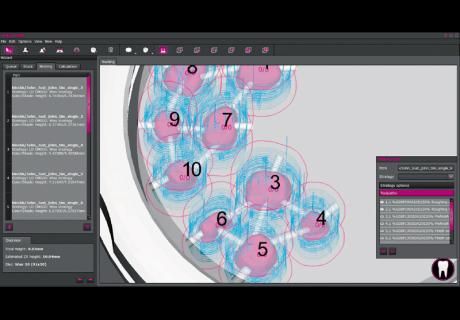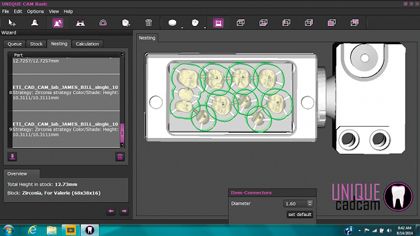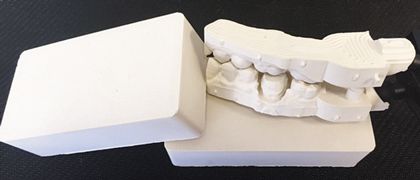How ETI Digital Technology's UNIQUE CAM software can improve your milling workflow
We recently spoke to John Just, the director of technical support at ETI Digital Technology, to learn about two such unique offerings.
Talking to John Just about the strategies behind UNIQUE CAM and ETI's millable gypsum.

ETI Digital Technology specializes in offering whole workflow systems. It sets labs up with a complete CAD/CAM solution, giving them everything they need to go fully digital. ETI also prides itself on being more than a reseller. It offers options to its systems that are not available from any other distributor.
We recently spoke to John Just, the director of technical support at ETI Digital Technology, to learn about two such unique offerings. Here’s what he told us about going digital, new millable materials and developing CAM software that doesn’t require an engineering degree.
Can you tell us a little bit about yourself? What is your background and your role at ETI?
I have been a dental technician for more than 43 years, owned a lab for 37 of those years and, before I did all of that, I worked for a company where I ran a mill/lathe. I brought that experience with me through dentistry. I am [now] the director of technical support [at ETI Digital Technology], and I ensure we maximize the use of these machines in the laboratory.
Tell us about the decision to create UNIQUE CAM. What were you hearing from labs that led you to develop this product?
Feedback from labs was that there was no software on the market that was user-friendly-that you had to be an engineer to use the CAM software that was available. [And they] were correct-the CAM software that was being used came from the automotive or aerospace industries, and we were converting them to make teeth. As we began selling more mills, I felt there had to be something better on the market for labs to use.
I had a connection in Germany, Dr. Reiner Rosin, who has two PhDs in science and computer engineering, and I said, “There has to be a better way to do this.” We began working together, and he sent me his first draft of what he created. It was good, but it wasn’t exactly user-friendly for dental technicians. So for about six months, he and I worked very closely together sending ideas back and forth. I would test everything he suggested, and, finally, we came together to develop the software that is now known as UNIQUE CAM.
We want to validate everything we sell to ensure it works in the equipment properly. Sometimes when you have a block of zirconia in the mill, depending on the manufacturer, the material might be hard or soft. These machines were designed to work with metal. The restorations require a lot of hand finishing. We were able to create our own strategies and mill precisely without needing a technician to hand finish the case afterwards. Dental technicians need to be able to mill a case that does not require a lot of hand-finishing.
What challenges did you have to overcome in getting a CAM software you were happy with?
The biggest issue we encountered was that the manufacturers of zirconia don’t all maintain the same standards. We found so many of them [varied]. This batch was this shrinkage, that batch was that shrinkage, etc. It varied a lot; we’ve gone from seeing shrinkage factors in the teens to 35-40 percent. That cuts down what can be done and changes the strategies. We’re constantly testing materials and products, which was a big challenge.
A lot of labs would buy their product from [off-brand, overseas] companies so we didn’t know the structure or the type of zirconia that was being used. We would get calls saying, “the bridge just broke,” and we’d ask about the manufacturer of the zirconia and the customer wouldn’t know it so we wouldn’t be able to duplicate or test the material. Dr. Rosin didn’t want to produce 250 strategies the lab would have to test. As it is, we have three to four strategies that go for veneers, bridges and so on. We make it work. That was one of the challenges.
The other [challenge] is that “lab guys” tend to follow the crowd. Because we were not the first CAM software out there, and most technicians were already familiar with other programs, a lot of them were hesitant to make the switch to UNIQUE CAM. The only way to win them over was to invite them to our office and show it to them in person. They saw that UNIQUE CAM was ready for the mill, and they were on board. Roland will soon be introducing their wet mill, and we already have many labs that have said they will buy the mill as long as it comes with UNIQUE CAM.
What do you think UNIQUE offers milling machine users that stock software can’t match?
What we noticed is that several of the CAM software [options] ran the spindle at full speed no matter what they were cutting. Most of the mills require air blowing on them or they use liquid to keep them cool, otherwise PMMA would melt and stick to the milling tool. Same with zirconia; some of them had such a high spindle speed rate that it would crack the zirconia. You wouldn’t notice that until the disc was milled and the pieces fell out.
We tried to circumvent that and develop particular strategies for particular restorations. We’re an open system so we don’t hold users to [any particular CAM system]. We tell our customers that if they want to use another software, they can, but if they use UNIQUE, they can give us a call for tech support at any time.
We have specific strategies for the zirconia we sell. We even have a strategy for millable gypsum. I am a part of ETI Empire Direct, one of the largest gypsum distributors/manufacturers on the West Coast. We saw that there was going to be a large opportunity to use millable gypsum as intraoral scans came to the market so doctors can show their patients models. ETI developed a gypsum that can be milled without creating a lot of dust. The best part is that users don’t have to worry about expansion/shrinkage/setup. Several of the labs that are using our millable gypsum have two mills. One mills the model and one mills the restorations. So, when it is finished, they have a model and the restoration completed.

The nesting process in UNIQUE CAM for a DWX-4 Mill (Roland DGA)
In your time working with customers, what’s been the user experience (and results) of people who have used their milling machines with UNIQUE CAM?
To put it in one phrase: They love it. The learning curve is very short-only about a day or so. It is so versatile that a lot of the developers of other CAM software programs on the market have seen our software and are attempting to match our capabilities. We’ve been working on specialized strategies specifically meant to maximize the capabilities of the Roland DGA DWX-4, as well as the DWX-50 [beyond what “came in the box”]. The specialized strategies we have come up with include those specific to milling surgical guides, models and much more. We’re able to mill more units on one disc. We lay everything down in a specific pattern, and you just have to spread it out. We are able to use a whole disc, and we get a very nice turnaround. Everybody loves it.
How does UNIQUE fit into the CAD/CAM workflow?
Really, you don’t have to change anything. The CAM software is pretty much a standalone software. For the Roland DGA mill, you have a V-panel, which feeds the file to the mill for manufacturing. For the UNIQUE CAM, we take files from any open CAD software so they send it directly to the mill. Something we discovered early on in the development of this software was that everyone wanted STL files. Well, an STL is only a picture. We need to know exactly where the margin is. This resulted in a lot of hand finishing. A lot of the old CAM software would make the margin too thick because it was guessing where the margin line should be. We decided we needed another file type. We work with Dental Wings, and they have several output formats, one of which gives us all the numbers so we have everything we need to know to successfully and accurately create our case. We incorporated that a long time ago. I’ve noticed a lot of the other CAM software is [now] exporting a numerical file. That’s what’s becoming important.
We also incorporated a setting into UNIQUE CAM that allows users to see the layers on the screen when using a multilayer PMMA or zirconia. This allows you to get a blended finish. Being a dental technician, I felt this was a necessary addition to our software. We’ve pretty much surpassed most of the CAM software out there because while they were more interested in the machining, we were more interested in how we could get the best result out of the mill.
What was the engineering like to develop the millable gypsum?
We had to mill about 500 discs all made from different formulas. We tried different colors, putting resin in it, mixing it with plaster, mixing it with agents to cut down the dust ... all kinds of things. A lot of trial and error went into the development of the gypsum. We just kept blending and testing. The fact that we could work on the finished product meant we really didn’t care if it expanded a lot or a little. We make stone that does both, and we’d figure out a good blend for a perfect model. And these do that.
The milled models come out of the mill, and they look like they had been poured in the most perfect condition you could do in the lab. There are no air bubbles or swirling marks. As long as the scan being used is good, you end up with a perfect model. We can scan the impression in 10 minutes, send it to the mill and, in an hour, have both an upper and lower ready to articulate for presentation and be worked on. With all these newer materials, like nanocomposites, the labs can get back to delivering a crown within a few hours! Whenever you use zirconia, there’s a long firing cycle that prevents same day turnaround, but newer materials enable same-day turnaround.

Millable gypsum from ETI Digital Technology
What’s the response been from dentists?
They don’t believe the models have been milled. They think the labs have been pouring them up. They do really nice finishing work and remove all the sprues to hold it in place on the disc. It’s all the same color, it’s not dirty and the doctor can show the patient everything. The model matches exactly what the scan was because that’s what the computer recognized. The doctors really like the fact that nothing was adjusted.
Anything else you’d like to add?
Any dental technicians today who are just getting into CAD/CAM are the shy ones. They’re the ones who have held back because they’ve heard rumors about obsolete technology. They’ve been very cautious. And to give them something that requires them to have a degree in engineering makes them feel like they were right and shouldn’t have gotten into CAD/CAM. UNIQUE changes that. There’s only one screen, and it’s very user-friendly. The idea is that this is something they’ve never used so they’re very timid. But now, with UNIQUE, if you like what you see on the screen, you’ll like what the mill will produce. That’s swaying the people who were previously reluctant to get into digital dentistry.
For more information about ETI Digital Technology or any of its product offerings, call 800-451-7778 or visit etidigitaltechnology.com.